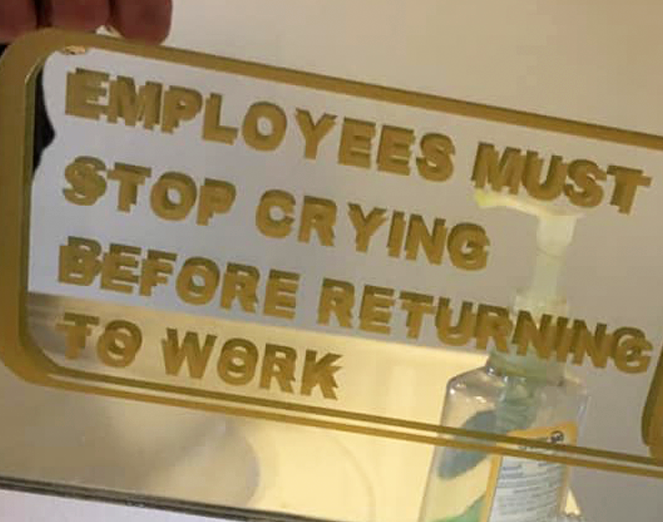It’s out of control. Here’s me trying to lay down this rule a couple weeks back: https://lemmy.world/comment/10616445
- 0 Posts
- 644 Comments

 5·2 days ago
5·2 days agoYes, but it’s a little worse than that. One might take that to mean environmental, congenital, or even genetic factors. But there’s more. Consider the role that trauma has to play here as it can directly cause arrested psychological development:
Ah, I see the problem. The punctuation is wrong.
But as who we really are
,fellow Americans.FTFY

 2·7 days ago
2·7 days agoDon’t give them any ideas!

 2·7 days ago
2·7 days agoYou’re not alone. I recall getting sniped from every direction at some points, with very tough 1:1 battles and boss battles that just kinda “happen” out in the open.
looks like purgatory
Having visited with family that “retired out to the country”, I can tell you that it feels like purgatory as well.

 141·8 days ago
141·8 days agoThat’s alarmingly low - it suggests that it doesn’t take much for any given influencing campaign. If there are fifteen discrete such campaigns in play, that’s just 1/100 of everyone. Now imagine that there’s tens of such campaigns, and the numbers look even more reasonable. Also, it’s probably cost-effective at this scale since this has been with us a while, which is terrifying.
What I want to know is: what percentage are human users that ate the
onionmetaphorical tequila worm1 and are now parroting these trolls?1. Follow me here: drink a bottle and eat the worm inside. You’re not thinking straight and did something you wouldn’t do if you had your wits about you, or maybe a friend nearby that is thinking clearly. Propaganda has a way of forcing you into a phantasm by emotional manipulation, making it easy to jam all kinds of nonsense into your head. Extending the metaphor, said propaganda also lays out how to defend your worm eating habit as though it’s totally normal to do.
Possibly? Or maybe people will think twice about deadnaming you.

 1·8 days ago
1·8 days agoI mean, maybe if you bake a stone cold potato that was in the fridge and then cook it for two hours? But even then we’re probably talking about a handful of minutes at the most.

 3·8 days ago
3·8 days agoWhich
car companybar did you say you work for?A major one.

 5·8 days ago
5·8 days agothey’re just mad because they didn’t think to do what Uber is doing and now they’re dying.
That and they’re mad because their virtual monopoly status didn’t protect them from market disruption. They just sat back, assuming that there was no way these rogue taxi services were going to evade the law for long. The fact that an entire industry acted on such a bad take suggests, to me, a lot of anti-competitive bullshit behind the scenes.
Anyway, I agree. All they had to do was either add rideshare-like features to their service, merge with rideshare services, or become one themselves. The investment capital was clearly there, and making a modernization pitch with brand recognition of an established taxi company would have been a slam-dunk.

 7·9 days ago
7·9 days agoJust automatically started uploading everything on my hard drive to an account I didn’t set up
Wait, what?

 2·9 days ago
2·9 days agoReal question here: has anyone else had luck side-stepping the Live365 signup during/after install? I’ve done this, and I’m very confused that more people haven’t.
I totally get that: use the right tools and you’ll be okay. This applies to many technologies in this space.
With respect, I still take this advice like hearing “look out for rattlesnakes if you’re hiking there.” It might be safer to just hike where there are no rattlesnakes, instead.
I swear, overcoming fixed functional-ness is like a superpower when you can apply it.
I once shared a small office with a co-worker. I had the idea to move the desks away from the walls and place them back-to-back, diagonally, in the middle of the room. Other co-workers scoffed and remarked at how dumb and unconventional this looked. Then I explained that we each now had nearly full privacy from each other, much more personal space in our respective corners, no more glare from the window, and nobody could sneak up on us from the door anymore. Things got pretty quiet after that.
Useful? Not exactly. But you’d never look lazy or idle, that’s for sure.
/me goes back to get second folding chair.
Pascal went to military school.
I’m not in love with the idea, but a language that cuts out the BS has a sudden appeal when on a group/team project.
I take this as less of a “I can’t use this intuitive feature reliably” thing and more of a “the truth table will bite you in the ass when you least expect it and/or make a mistake” thing.



Sorry to hear about your friend. While I’m no doctor, that seems to fit the bill to me. I’ve known people that had other trauma when young, and yeah, maintaining healthy relationships seems to be the hardest thing for them. Your story reminded me of a lot.